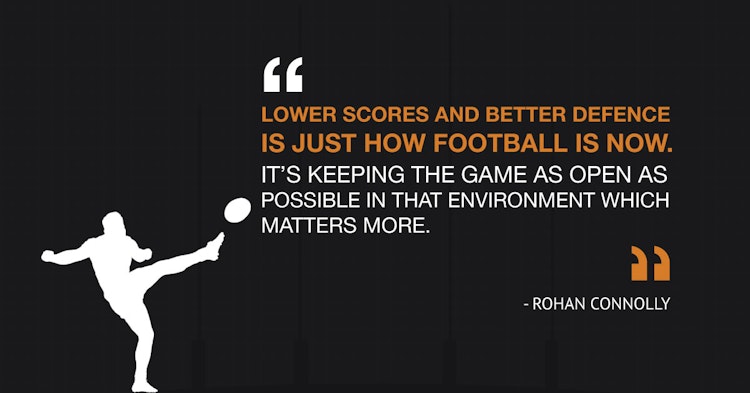Analysing The Effect Of The 2021 AFL Rule Changes
Last updated: Jul 5, 2021, 5:42AM | Published: Jul 5, 2021, 4:16AM
This has been a pretty good AFL season. We’re seeing some different teams, such as Melbourne and the Western Bulldogs, at the top of the ladder. We’re seeing reigning title-holder Richmond questioned like seldom before during its five-year spell at the top.
We’ve also seen some terrific games, surely more of them than in recent seasons. There’s close to a dozen which spring to mind straight off the top of my head.
We had that epic between West Coast and Richmond in Perth, Geelong’s win after the siren over the Western Bulldogs, the Dogs’ early-season win over the Eagles and Port Adelaide’s narrow shave against Sydney a couple of weeks back.
At the very least, we’ve had no earnest debate (as yet) about the “state of the game”, which has become an almost annual exercise in recent times. That in itself is something for which to be thankful.
RELATED: Check out all of Stats Insider's 2021 AFL season projections
So to what extent have the much-publicised slew of rule changes for the 2021 season made a difference? Well, the bad news is not nearly as much as was being heralded early on this year. The good news? That perhaps not that much change was needed to have at least some sort of impact.
There was no end of celebration about the impact of the “man on the mark rule”, greater room given to players kicking in from a behind and the reduction of the interchange cap from 90 to 75.
In fairness, the changes did seem to make a distinct difference to how the game was being played early this season. But the key word was “early”. And the race to make definitive proclamations about the impact was always premature.
Of course, the modern media news cycle being what it is, those who were so intent on making the sweeping statements have long since lost interest and moved on to other sources of hyperventilation.
But now we’re 16 rounds into a 23-round season and there is a reasonable slice of data to look at. So, for those interested enough to still be paying attention, what does it show? That the changes in real terms, have been marginal.
Scoring has (often incorrectly) been used as the real barometer. Currently it sits at 81.1 points per team per game. That’s less than one point up on 2019 (the last regulation season), which still makes it the second-lowest scoring year since 1967.
That 81.1, perhaps not surprisingly, is significantly down on the 85.6 at which we were going after three rounds this season.
The more significant measuring stick, but one not as obvious to the naked eye as the numbers on the scoreboard, is stoppages and transition. And here, the numbers are more interesting.
After 16 rounds, there has been an average of 56.2 ball-ups and throw-ins per game. That’s the lowest figure for some time, nearly 10 less per game than the 65.8 of two years ago, and way down on the peak of 70.7 we reached in 2015.
RELATED: Why The AFL's Dinosaurs Are Still Thriving
So, less congestion. More corridor football as teams are more encouraged to go inside with the man on the mark now effectively glued to the spot. Which means fewer throw-ins.
And end-to-end football? Well, this season, the rate of defensive 50 to inside 50 chains of possession is currently at 21.3%, substantially up on last year’s (adjusted) figure of 17.7%, and the highest figure since before 2015.
Clearly, it appears like we’re seeing more coast-to-coast play and less locking of the ball inside a team’s forward 50 for protracted periods. In my view, that alone is a big plus for the aesthetics of the game.
Tempo remains the big issue, in my view. When coaches were still adjusting to the new man on the mark rule early this season, there was a speed on the game the likes of which we hadn’t seen for years. It was terrific to watch.
Now there’s been ample time to recalibrate defensive strategies, there’s greater inhibition from the team with ball in hand, more discretion shown in the picking and choosing of the right moments to go flat chat or instead play a slow, methodical brand, with Geelong and Brisbane two pretty good examples.
There’s been more excruciating stuff to watch amidst the good games lately, the round 16 examples of Hawthorn-Port Adelaide and Collingwood-St Kilda standing out, the Hawks and Pies both heading to half-time with a solitary goal to their names.
But dour football does tend to go hand in hand with the month of July. It’s that difficult period between when the foundations are laid for a campaign, and when the finals assault gears up, arguably the main priority at the moment staying healthy, fit and simply in touch in terms of the ladder. Quality of football is hardly a priority.
I think what we can conclude now about the 2021 rule changes is that they underline one, perhaps sad fact. That no matter how much we pine for the days of big scores and 100-plus goalkickers, they ain’t coming back.
Lower scores and better defence is just how football is now. It’s keeping the game as open and with as much end-to-end play as possible in that environment which matters more. And even a little change in that regard has made for a better product in 2021.
Perhaps, in time, we will still need to go further. But for now, even that will do.
*You can read more of Rohan Connolly’s work at footyology.com.au
Did you enjoy this article? Join our free mailing list to get the best content delivered straight to your inbox, or join the conversation by leaving a comment below or on the Stats Insider Twitter or Facebook page.



